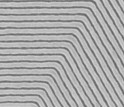|

Press Release 05-092
Self-Assembling Nano-Electronics Turn a Corner

June 2, 2005
Researchers at the University of Wisconsin-Madison have taken another big step toward complex, nanoscale electronic devices that can be directed to assemble themselves automatically—a development that would allow manufacturers to mass-produce "nanochips" having circuit elements only a few molecules across, roughly 10 times smaller than the features in current-generation chips.
Writing in the June 3 issue of the journal Science, UW chemical engineer Paul Nealey and his colleagues describe how carefully chosen mixtures of polymers can be made to assemble themselves into nanoscale patterns that turn corners and exhibit other complex geometries. Their approach builds upon a similar technique they demonstrated two years ago, using a simpler mix of polymers that could self-assemble only into regular, straight-line patterns of stripes.
The researchers carried out their work at the university's new Nanoscale Science and Engineering Center on Templated Synthesis and Assembly at the Nanoscale, which is funded by the National Science Foundation (NSF).
For more information, see the University of Wisconsin News Release.
-NSF-

Media Contacts
James C. Beal, University of Wisconsin-Madison (608) 263-0611 jbeal@engr.wisc.edu
M. Mitchell Waldrop, NSF (703) 292-7752 mwaldrop@nsf.gov
Program Contacts
Thomas P. Rieker, NSF (703) 292-4914 trieker@nsf.gov
Related Websites
UW Center for Nanotechnology: http://www.nanotech.wisc.edu/
UW Nanoscale Science and Engineering Center: http://www.nsec.wisc.edu/

The National Science Foundation (NSF) is an independent federal agency that
supports fundamental research and education across all fields of science and
engineering, with an annual budget of $6.06 billion. NSF funds reach all 50
states through grants to over 1,900 universities and institutions. Each year,
NSF receives about 45,000 competitive requests for funding, and makes over
11,500 new funding awards. NSF also awards over $400 million in
professional and service contracts yearly.
 Get News Updates by Email Get News Updates by Email
Useful NSF Web Sites:
NSF Home Page: http://www.nsf.gov
NSF News: http://www.nsf.gov/news/
For the News Media: http://www.nsf.gov/news/newsroom.jsp
Science and Engineering Statistics: http://www.nsf.gov/statistics/
Awards Searches: http://www.nsf.gov/awardsearch/
| 


